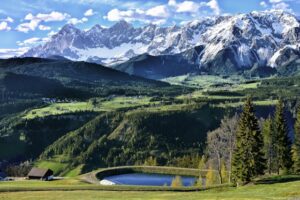Physical Address
23,24,25 & 26, 2nd Floor, Software Technology Park India, Opp: Garware Stadium,MIDC, Chikalthana, Aurangabad, Maharashtra – 431001 India
Physical Address
23,24,25 & 26, 2nd Floor, Software Technology Park India, Opp: Garware Stadium,MIDC, Chikalthana, Aurangabad, Maharashtra – 431001 India

In a remarkable event that underscores the far-reaching impacts of climate change, Switzerland and Italy had to recently redraw part of their shared border in the Alps due to the melting of glaciers. Unlike typical border adjustments that often result from political conflicts, this shift has been necessitated by environmental changes—a stark reminder of the influence of global warming on the physical geography of nations.
Switzerland officially ratified the new border, which affects the region around the iconic Matterhorn mountain, in May 2023 and now awaits approval from Italy. While the redrawing of borders in peacetime may seem unusual, the cause is anything but benign: climate change-induced glacial melting.
How Are Melting Glaciers Changing the Border?
The original border between Switzerland and Italy runs through some of the highest points of the glaciers along the Alps, including the glacier on the Matterhorn. These ridgelines, which also mark the point at which melting ice could flow into either country, naturally serve as the division between the two nations. As glaciers retreat due to warming temperatures, the ridgeline shifts, taking the border with it. In this case, as the glacier on the Matterhorn melted, the ridge that once marked the boundary between Italy and Switzerland moved further into Italian territory, giving Switzerland a small amount of additional land.
This border change, driven entirely by natural phenomena, raises several important issues. Glaciers have historically served as stable and clearly defined markers of national boundaries. However, as these glaciers retreat due to climate change, it complicates not only cartography but also matters of international responsibility and cooperation, especially when it comes to managing the natural resources in the area.
Why Does the Border Shift Matter?
The Alps, particularly the region surrounding the Matterhorn, are a hub for tourism, particularly winter sports like skiing, mountaineering, and snowboarding. The Swiss resort of Zermatt is world-famous, drawing hundreds of thousands of tourists each year to its pristine ski slopes. The Swiss-Italian border is essential because many of these ski resorts share terrain between the two countries. Italian ski resorts also depend heavily on this cross-border tourism, making seamless access to shared alpine areas critical for the economy of both nations.
The tourism industry in this region is deeply interlinked, meaning that changes in geography could have far-reaching economic consequences. The retreat of glaciers not only affects the physical terrain but also ski slopes, which depend on stable snow and ice conditions. If the glaciers continue to recede, it could reduce the available area for skiing and impact the broader economy that thrives on winter tourism.
Furthermore, the responsibility for maintaining the glaciers, and ensuring their health, falls on the country where they are located. A clear boundary is essential for each country to know which parts of the glaciers they are responsible for. With glaciers disappearing and borders shifting, Switzerland and Italy must determine how best to manage the diminishing ice, ensuring the area remains safe and accessible for tourists while mitigating environmental risks.
European Glaciers and Climate Change
The Alps are far from the only region in Europe facing the effects of rapid glacial retreat. Across the continent, glaciers are shrinking at an alarming rate. According to the World Economic Forum, Swiss glaciers alone have lost 10% of their volume from 2021-2023, following a staggering 6% loss in 2022. This 10% cumulative ice loss over just two years is equivalent to the total volume of ice lost between 1960 and 1990.
The scale of these losses is extraordinary. In some areas, particularly those above altitudes of 3,200 meters (approximately 10,500 feet), glaciers have lost up to 3 meters (about 10 feet) of ice between 2022 and 2023. This rapid melt is not only a concern for local ecosystems and industries but also global sea levels, as glaciers play a crucial role in regulating the Earth’s water cycle.
Europe’s glaciers are particularly vulnerable because of the continent’s proximity to the Arctic, a region that is warming faster than any other part of the planet. Additionally, the surrounding atmospheric and oceanic currents are becoming warmer, exacerbating the melting. According to the European State of the Climate 2023 report, this trend is expected to continue, with increasingly erratic weather patterns causing further glacier melt.
References:
https://www.weforum.org/agenda/2023/10/switzerland-glacier-ice-melt
https://nsidc.org/learn/parts-cryosphere/glaciers/why-glaciers-matter
https://climate.copernicus.eu/esotc/2023
ImageSource: https://www.pexels.com/photo/landscape-of-hills-and-plains-in-winter-16235058/
Banner Image: Photo by Daja https://www.pexels.com/photo/green-field-544067/